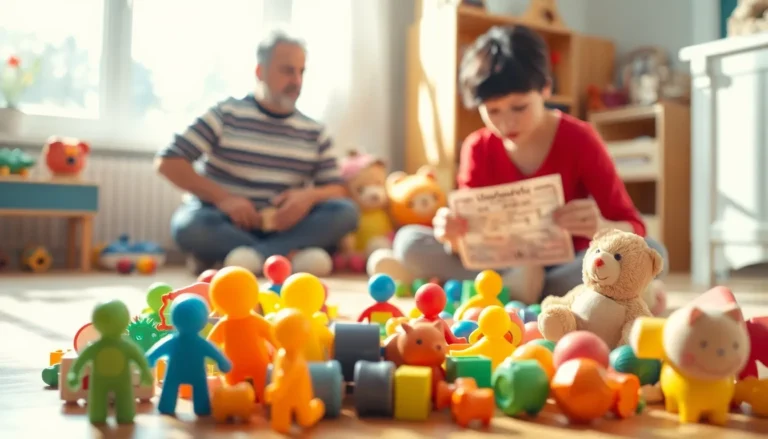In the whirlwind of lesson plans and grading papers, it’s easy for teachers to feel like they’re juggling flaming swords while riding a unicycle. Amid the chaos, mindfulness emerges as a lifeline, offering a way to reclaim focus and sanity. Imagine stepping into your classroom with a calm mind, ready to inspire students rather than just survive another day.
Table of Contents
ToggleImportance of Mindfulness for Teachers
Mindfulness plays a crucial role in the lives of teachers. It enhances clarity and resilience, equipping educators to handle classroom stress.
Benefits for Personal Well-being
Mindfulness cultivates emotional stability, allowing teachers to process their daily experiences with greater ease. Regular practice reduces anxiety and enhances overall mental health, resulting in improved life satisfaction. Engaging in mindfulness techniques such as deep breathing and meditation fosters a positive outlook. Personal well-being translates into higher energy levels and a more balanced lifestyle, enabling teachers to engage fully in their work and personal lives. Furthermore, mindfulness encourages self-compassion, empowering educators to manage setbacks more effectively.
Benefits for Professional Practice
Mindfulness sharpens focus and concentration, essential skills for effective teaching. Teachers who practice mindfulness exhibit improved classroom management abilities. Increased patience and heightened awareness lead to more meaningful interactions with students, promoting a supportive learning environment. Mindful educators model emotional intelligence, demonstrating how to manage stress and build resilience. Implementing mindfulness practices can also enhance creativity, encouraging innovative teaching methods that resonate with diverse learners. Better decision-making stems from a calm mindset, influencing classroom dynamics positively.
Mindfulness Techniques for Teachers

Mindfulness techniques offer practical ways for teachers to enhance their focus and well-being. Incorporating these strategies into daily routines can result in a more positive and effective teaching experience.
Mindful Breathing Exercises
Mindful breathing exercises cultivate awareness and reduce stress. Focusing on the breath allows teachers to center themselves during hectic moments. To practice, inhale deeply through the nose for a count of four, hold for four, then exhale through the mouth for four. Repeating this cycle for five minutes fosters calmness and clarity. Integrating these short sessions throughout the day can make a significant difference in managing classroom challenges. Even a few minutes can refresh the mind and promote resilience.
Body Scan Meditation
Body scan meditation encourages teachers to reconnect with their physical state. By directing attention to various body parts, educators can identify areas of tension and relaxation. Starting from the toes, one can progressively focus on the legs, torso, arms, and head. This practice highlights bodily sensations and fosters greater self-awareness. Spending 10 to 15 minutes on this meditation regularly can lead to improved emotional balance and enhanced concentration. Practicing in a quiet environment maximizes benefits and rejuvenates the mind for teaching responsibilities.
Integrating Mindfulness into the Classroom
Integrating mindfulness techniques into everyday classroom practices fosters a more focused and calm learning atmosphere. Teachers can enhance students’ educational experiences by nurturing this approach.
Creating a Mindful Environment
Creating a mindful space begins with setting the physical classroom. Visual aids such as calming colors or inspirational quotes can promote tranquility. Soft lighting enhances relaxation and helps reduce anxiety. Additionally, incorporating plants around the classroom connects students with nature, contributing to a serene ambiance. Regularly designating “mindfulness minutes” gives students a moment to pause, breathe, and refocus, shifting their attention from distractions. Establishing classroom routines that prioritize mindfulness strengthens emotional well-being and builds a supportive community among students.
Incorporating Mindfulness into Lessons
Incorporating mindfulness into lessons enriches students’ engagement. Teachers can start lessons with a brief mindfulness exercise, like a few deep breaths or a short meditation. This practice centers students’ attention and prepares them for learning. Using storytelling techniques that include themes of mindfulness can foster deeper connections and enhance lesson retention. Practicing mindfulness during group activities nurtures collaboration and communication skills. Integrating reflection sessions encourages students to process their thoughts and emotions, promoting self-awareness. These techniques create an inclusive environment where students feel valued, which enhances their overall learning experience.
Overcoming Challenges in Practicing Mindfulness
Practicing mindfulness presents unique challenges for teachers, yet overcoming these barriers is essential. Time constraints and skepticism from peers often hinder the integration of mindfulness into daily routines.
Time Management for Mindfulness
Teachers face demanding schedules, making time management crucial for mindfulness practice. Schedule brief mindfulness sessions during breaks, allowing moments of grounding amidst busy days. Prioritize short exercises over longer sessions to fit into tight timelines. Incorporate techniques such as mindful breathing at the start of classes, helping create a more focused environment. By using these strategies, teachers integrate mindfulness seamlessly into their routines, enhancing both personal well-being and classroom effectiveness.
Addressing Skepticism Among Colleagues
Skepticism among colleagues can impede collective mindfulness efforts. Open conversations about mindfulness benefits foster understanding and acceptance. Share personal experiences and positive outcomes to illustrate mindfulness’s potential impact on teaching practices. Hosting small group sessions can demystify mindfulness exercises and provide a platform for experiences. Encourage a culture of curiosity rather than criticism, creating an environment supportive of embracing mindfulness in shared teaching methods.
Mindfulness offers teachers a pathway to navigate the complexities of their roles with greater ease and effectiveness. By prioritizing their own well-being through mindful practices, educators can foster a more positive and engaging classroom environment.
Incorporating techniques like deep breathing and body scan meditation not only enhances personal resilience but also enriches student interactions. As teachers embrace mindfulness, they cultivate emotional intelligence and creativity that benefit both themselves and their students.
Ultimately, adopting mindfulness in education transforms the teaching experience, creating a supportive atmosphere that nurtures growth and learning for everyone involved.





